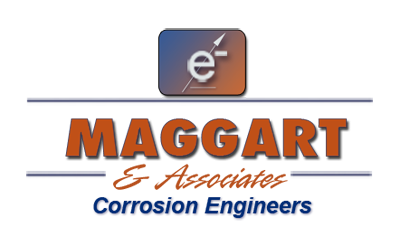Maggart & Associates designs, installs and provides to its customers an impressed current or galvanic cathodic protection system for the interiors of water tanks. Water tanks may be potable water or fire suppression water, welded steel or bolted. Because water tanks and storage structures are expensive to build, operate and maintain, it is more economical to protect water tanks with Maggart NSF Certified cathodic protection systems than rebuild them.
Cathodic Protection is a popular and efficient way to provide extended coating life and extended tank structural life on the submerged area interior of a water tank. Cathodic Protection has been done on water tanks for decades and has proven to greatly increase the life of a coating system on tank interiors. Structural integrity is also maintained better when cathodic protection is used and maintained. We have been doing water tank cathodic protection systems since 1980 and have installed 100’s of systems around the country.
Operators have begun to see the value of corrosion protection from both the coating and cathodic protection approach. For more information on cathodic protection and corrosion basics see our page on CP101.
Maggart & Associates impressed current cathodic protection system is approved for drinking water exposure by NSF to meet standard ANSI/NSF Standard 61 Drinking Water Exposure. Certification documents are available upon request. All of our systems are designed to meet AWWA D 104 and NACE SP 0388-2014 standards for impressed current cathodic protection design, installation and testing.
Impressed Current Cathodic Protection for Water Tanks is of two general configurations:
This system offers the advantage of anode access while the tank is filled with water. If the tank location is south of an E/W line at the Tennessee/Kentucky border or the Colorado/New Mexico border and below an elevation of 3,000’MSL a suspended system can be used. Consider also history of minimal interior icing, the owner of the tank should know if icing inside the tank is an issue that may damage roof suspended anodes.
If north of the described boundary and or above 3,000’ MSL a floating system is recommended. The advantage is that it is less susceptible to icing, not icing proof. The main disadvantage to this type system is the need to drain the tank if there is some repair or maintenance of the interior cathodic protection system required.
Cathodic Protection of “on grade fire water tank bottoms” is a DOD design requirement for fire water tanks. Maggart and Associates have done “on grade tank bottoms” for many different types of tanks.
We have a galvanic (passive) cathodic protection system for bolted water storage tanks. Our design is a distributed anode system which we specifically recommend for bolted tanks. See specification available for download below.
For information on underground Water Transmission pipe solutions, visit our page at Pipelines.
The following documents are available free of charge, please register your email address and contact information for us to contact you, or simply click on the link.
This document is specific to DOD/Military construction. We can edit this guide specification from the master if you wish but will need to know some site specific information. Please email or call us and an engineer will contact you. We serve as design AE Sub on many military design projects for underground pipe systems and water tanks. Specification is no charge available in .sec or .pdf.
Please click here for our DOD/Military Page
Check Out How Our Systems Work On The Links Below and Click The Link To Download Drawings for Cathodic Protection Systems by Maggart:
Phone:
(770) 934-8579
(770) 414-4200
Address:
P. O. Box 1846
Tucker, GA 30085
